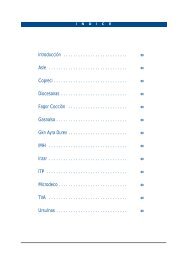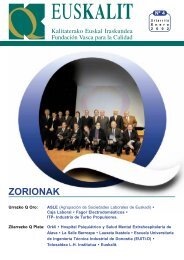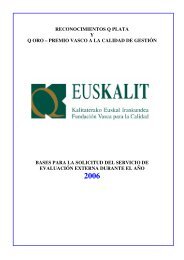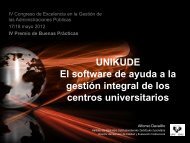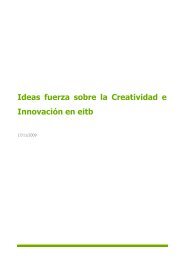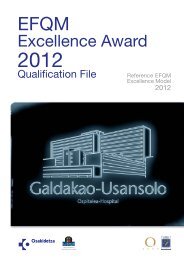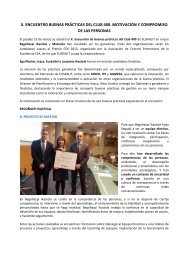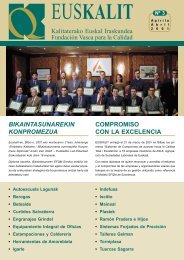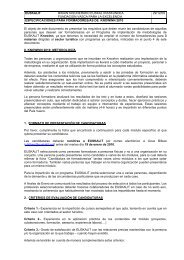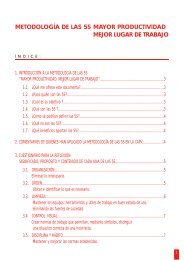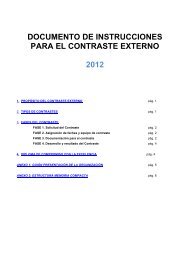Olabide Ikastola - Euskalit
Olabide Ikastola - Euskalit
Olabide Ikastola - Euskalit
You also want an ePaper? Increase the reach of your titles
YUMPU automatically turns print PDFs into web optimized ePapers that Google loves.
people<br />
3 PEOPLE EFQM Excellence Award 2010 27<br />
Strategic Reflection and subsequently managed through the Communication<br />
Plan Process. In this respect, the Process for Drawing<br />
Up the Technology Plan has contributed greatly in recent years to<br />
improving our approach in this area of management, providing<br />
technological support in our effort to improve communication<br />
throughout the school.<br />
The objectives of the communication plan are:<br />
• to align individual and team objectives with <strong>Olabide</strong> objectives,<br />
3b;<br />
• to secure the commitment and integration of all our people;<br />
• to create a relaxed, united atmosphere among our people; and<br />
• through constant system review activities, to generate ideas to<br />
improve the communication system itself.<br />
The plan provides for a series of actions covering top-down,<br />
bottom-up and horizontal communication, thus ensuring and<br />
facilitating the correct flow of feedback and information to and<br />
from our people and, in the case of horizontal communication,<br />
teamwork and participation. The different communication channels<br />
covered in the plan and progressively deployed and improved<br />
over time in the school include:<br />
• meetings;<br />
• e-mail, website and intranet;<br />
• suggestions box;<br />
• pigeon holes, notice boards and blackboards;<br />
• in-house publications and internal documents; and<br />
• presentations and celebratory events.<br />
Informal communication channels in the school, designed to<br />
promote everyday contact and information exchange among our<br />
people and to improve the general working atmosphere, include<br />
teachers’ rooms and administration areas equipped with coffee<br />
machines. Similarly, informal lunches and dinners are organised<br />
regularly, and informal meetings to discuss day-to-day matters<br />
bring to light issues which do not commonly arise in more formal<br />
meetings.<br />
Both an internal and an external communication plan have been<br />
drawn up. The Communication Plan Process involves defining the<br />
different communication channels to be used in each case, what<br />
type of communication is most suited to each channel, how often<br />
the information in question is to be communicated, who will communicate<br />
it and to whom. The communication plan also covers the<br />
communication needs of <strong>Olabide</strong> processes. Each process informs<br />
on its communication needs through a specific instruction requesting<br />
the process number and name, what needs to be communicated,<br />
how, when, by who, to whom and if a report is required.<br />
All new process communication needs are compiled by the person<br />
responsible for managing the communication plan and then<br />
processed within the Communication Plan Process. In <strong>Olabide</strong>, the<br />
priority channel for communication is meetings, as they are used<br />
for taking important decisions and for consolidating agreements.<br />
Additionally, meetings enable direct contact between our people,<br />
thus enriching feedback.<br />
The end purpose of improving communication in the school is to<br />
optimise how we share and communicate the <strong>Olabide</strong> MVV to all<br />
our people, so that all our people take active part in delivering the<br />
Vision of the school. Considerable effort has been made in recent<br />
years to equip the school with the technology required to maximise<br />
the effectiveness of communication. However, we also believe that<br />
close relations among our people are essential for sharing objectives,<br />
and it is for this reason that we still give great importance to<br />
direct communication through meetings. This can be seen through<br />
the number of meetings systematically planned and held at the<br />
different education stages, as shown below.<br />
Meeting Participants Frequency Report<br />
GB GB members,<br />
Every 3 Yes<br />
School Director and Head<br />
of Teaching<br />
weeks<br />
SC<br />
MT with certain members Every 3 Yes<br />
of the GB<br />
weeks<br />
MT MT members Weekly Yes<br />
Meeting Participants Frequency Report<br />
Education<br />
Yes<br />
stage<br />
Teachers, Heads of<br />
Education Stages and<br />
occasionally the School<br />
Director, Head of<br />
Teaching or even GB<br />
members<br />
IE; weekly.<br />
PE;<br />
fortnightly<br />
CSE and<br />
USE;<br />
fortnightly<br />
Department Department members Weekly No<br />
School year Those involved in class or<br />
school year<br />
IE, PE<br />
and CSE;<br />
weekly<br />
No<br />
Assessment<br />
Inter-stage<br />
(end of one<br />
education<br />
stage and<br />
beginning of<br />
next)<br />
Department<br />
Heads<br />
Guidance<br />
Area<br />
Admin. and<br />
Services<br />
Start of<br />
academic<br />
year<br />
Canteen<br />
coordinators<br />
Extracurricular<br />
activities<br />
coordinators<br />
Transport<br />
coordinators<br />
Tutor, specific teachers,<br />
Head of Education Stage<br />
and Head of Guidance<br />
Area<br />
Heads of Education<br />
Stages and Head of<br />
Guidance and Counselling<br />
Area<br />
Dept. Heads and<br />
Management<br />
Management and<br />
department members<br />
Head of Admin Area,<br />
administrative staff,<br />
maintenance, school<br />
caretaker and School<br />
Director<br />
GB representative,<br />
Management and staff<br />
Management and canteen<br />
coordinators<br />
Coordinators and their<br />
team<br />
Head of Admin. Area and<br />
coordinators<br />
IE, PE and<br />
USE; once a<br />
term. CSE;<br />
weekly.<br />
Once a year<br />
Fortnightly<br />
Weekly<br />
Weekly<br />
Once a year<br />
(Sept. 1)<br />
Monthly<br />
Once a term<br />
Once a term<br />
Yes<br />
No<br />
Yes<br />
Yes<br />
Yes<br />
Yes<br />
Yes<br />
Yes<br />
These and all other meetings held in <strong>Olabide</strong> are included in the<br />
communication plan. Since 2004-05, all <strong>Olabide</strong> people in the<br />
meeting at the start of the academic year are given a personal<br />
folder containing all the documentation they need on the BP,<br />
training plan, annual plan to develop the <strong>Olabide</strong> approach to<br />
language teaching-learning, a report on the previous year’s BP<br />
and documents on proposed actions for the forthcoming academic<br />
year. Any suggestions they may have on this information<br />
can subsequently be put forward.<br />
In 2007-08, as a result of MT reflection the previous year on how<br />
to present the BP in a more educational, dynamic and attractive<br />
way, the decision was taken to involve all members of the MT in<br />
the presentation event. This improvement action was designed<br />
to make the BP easier to understand and to involve more people<br />
in the process.<br />
The <strong>Olabide</strong> IT network has been systematically used by all our<br />
people for many years. In 2007-08, as a result of MT reflection on<br />
changing our approach to knowledge sharing, a cross-functional<br />
project team was formed to pilot the use of a moodle platform<br />
as a communication channel. This new tool led to more effective<br />
and efficient meetings, as all meeting agenda items could be<br />
worked on prior to the meeting through this platform. In relation<br />
to this, the objectives of the knowledge management plan,<br />
3b, are:<br />
• to generate an appropriate working atmosphere and the required<br />
basic support tools for the effective management of<br />
knowledge, 4e;<br />
No




